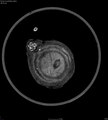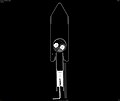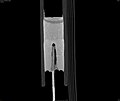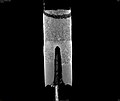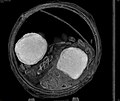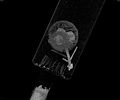Firework rocket
A fireworks rocket , like any rocket , is a pyrotechnic aircraft that propels itself by recoil and is used for simple fireworks . At the apex of the trajectory, various effects (stars, pop effects, crackling stars, etc.) are usually ejected.
Layout and function
A firework rocket usually consists of the following elements:
- a propellant
- an effect charge / payload with decomposition charge
The fuel in the propellant is mostly black powder , to which spark-generating substances such as coarse charcoal or aluminum and iron filings are added to create a nice spark tail. The propellant charges are optimized for the visual or acoustic effect and less for the performance. This basically differentiates the propellants of fireworks rockets from the model rocket propellants. The propellant ignites as soon as the ignition wire burns into it. The combustion creates a gas pressure which, bundled through the nozzle, creates the thrust to propel the rocket. As soon as the propellant has burned out, it ignites over to the effect charge. In rockets with a decomposing charge , the decomposing charge ignites first, which then immediately ignites the effect charge. The effect charge opens the top of the rocket; the "roof" is blasted off or, in the case of ball rockets, the spherical body bursts.
The effect set consists of coated flares, which can also be in cylinder form. The effect set is scattered approximately spherically symmetrically at the highest point (apex) of the trajectory by the decomposing charge . With loose rockets, the effect set is ejected from the rocket case without a decomposing charge. The spatial extent of the effect set is smaller, but the effect set density is greater. To achieve a flame color and simultaneously as oxidizing agents , various alkali metals and alkaline earth metal - salts used as barium for green, sodium nitrate for yellow and strontium nitrate for the red color. Mostly sulfur , charcoal and / or various resins are used as fuel . Silver sparks are generated with the addition of metal chips such as aluminum , titanium or magnesium . To distribute the effect charge at the apex of the rocket's trajectory, a little granular, loose black powder is finally added to the tip of the rocket.
Finally, a guide rod is glued to the side so that the rocket rises straight into the night sky . The guide rod, which is responsible for a clean flight path, moves the pressure point (the pressure point is the point at which all steering forces are combined) above the center of gravity and thus prevents the rocket from "overturning" in the air.
There are also firework rockets that are stabilized with the help of tail fins, similar to real rockets, so-called tail rockets . Although these rockets are smaller than those with guide rods and can also be launched without a special launching device, this type of rocket is much rarer for fireworks, as it is expensive to design these rockets in such a way that no stability problems arise in the launch phase. A tail unit with tail fins only works from a certain speed (from approx. 60 km / h). Until this speed is reached, the rocket would have to z. B. be guided by a guide rod. If the rocket has not yet reached this speed, a small gust of wind is enough to push the rocket into a shallow angle. Thus, a vertical ascent would no longer be guaranteed.
In the context of large- scale fireworks , fireworks rockets are increasingly being replaced by fireworks bombs that are fired from mortars :
- due to the increased safety distances
- because of their comparatively poorly predictable trajectory
- due to the difficulty of igniting them synchronously
Colours
Colors are created by adding elements and connections.
| generated color | required element / required connection |
|---|---|
| red | Strontium salts (dark red), calcium (orange), lithium (carmine red) |
| yellow | Sodium salts |
| green | Barium salts (yellow-green), copper (emerald green), tellurium (grass green), thallium (meadow green), zinc (pale green) |
| blue | Copper salts (azure blue), arsenic , lead , selenium (light blue) |
| violet | Cesium , potassium |
| purple | Rubidium |
| White; silver | Magnesium , aluminum , titanium , zirconium |
| gold | Iron , charcoal |
Legal
Fireworks rockets up to 75 g quantity ( net explosive mass ) are assigned to category F2 ( small fireworks , also consumer fireworks ) throughout the EU . In Germany, Category F2 rockets may only be given to people who have already reached the age of 18. In addition, the set amount is limited in Germany: Rockets with a net explosive mass of more than 20 g may only be given to persons who are appropriately qualified in accordance with the Explosives Act. In Austria , Spain and Belgium , fireworks of category F2 (without restrictions on rockets) can be purchased by people over the age of 16. In the Netherlands , category F2 items can be purchased from the age of 16, but there rockets are generally limited to 40 g net explosive mass. In Italy , category F2 items are only allowed to be purchased by adults with identification . Category F2 missiles with a set quantity of more than 35 g (as well as category F3) are only permitted for persons who have an official permit or a police permit to carry weapons.
health
safety instructions
Due to the existing risk potential, the use of pyrotechnic objects is only permitted in accordance with the instructions for use.
- Only CE- tested and approved pyrotechnic items should be purchased.
- Windows, balcony doors and shutters must be closed to prevent rockets from entering the house.
- Fireworks rockets should only be fired from a suitable and stable device (e.g. beverage crates). Free-standing bottles are usually not suitable as they can easily tip over.
- When shooting, close-fitting clothing made of cotton , denim or leather should be worn; In any case, no synthetic fibers , hoods , rolled up sleeves or trouser brims. Smoking is prohibited at the launch site. Rockets should always be launched in the direction of the wind and duds should not be ignited again.
- Fire extinguishers, preferably dry extinguishers and not foam extinguishers in winter, should be placed within easy reach
- Keep a safe distance from buildings, power lines, telephone lines and trees; because of the noise pollution, there is a large distance from hospitals, old people's homes, animal shelters, animal parks, mosques, churches and synagogues. Due to the risk of fire, at least 1.5 times the height of the rocket should be kept away from filling stations, warehouses, biomass heating plants, operating facilities and parking lots.
- Pyrotechnic objects, with the exception of fireworks that are intended for indoor use, must never be ignited in rooms.
- When using fireworks items, local burning bans must be observed; these are published by the respective municipality stating the affected area or can be requested from the responsible municipal administration. The offense constitutes an administrative offense. Burning bans exist regularly in medieval old towns or in areas with thatched roof buildings.
Gallery to build
Computed tomographic representation of a New Year's wing from the manufacturer / importer Weco Feuerwerk GmbH, type: Helios Mont Blanc panorama effect with bomb filling
Movies
Flight through the stack of images from the side.
Flight through the stack of images from top to bottom.
3D flight around the object. Semi-transparent rendering with phase contrasts.
2D sectional images
3D renderings
See also
Web links
Individual evidence
- ↑ . O V. Pyroland: Technical structure of fireworks. pyroland, accessed March 25, 2020 .
- ↑ . O V. Pyroland: Technical structure of fireworks. pyroland, accessed March 25, 2020 .
- ↑ § 20 Paragraph 4 No. 2 First Ordinance on the Explosives Act (1. SprengV) Pdf version ( Memento of the original from April 13, 2016 in the Internet Archive ) Info: The archive link has been inserted automatically and has not yet been checked. Please check the original and archive link according to the instructions and then remove this notice.
- ↑ Press release 2016/17 of the BMI p. 6 (PDF)
- ↑ Article 121 ff. Of the regulations on pyrotechnic articles and ammunition v. October 30, 2015 in the Boletín oficial del estado on November 7, 2015 (PDF, Spanish).
- ↑ Legal situation for the sale of pyrotechnic articles in Belgium (Dutch).
- ↑ Article 2.3.5 Vuurwerkbesluit of July 16, 2014.
- ↑ see Annex 1 for the regulation of consumers and theater fireworks .
- ↑ Art. 5.1.b) + c), Art. 5.2 to 5.4 Pyrotechnics Act 2010 (PDF, Italian)
- ↑ Safe handling of fireworks , accessed on December 31, 2012.
- ↑ o. V. pyrolager.de: Safe handling of New Year's fireworks. In: pyrolager.de. Retrieved March 25, 2020 .





